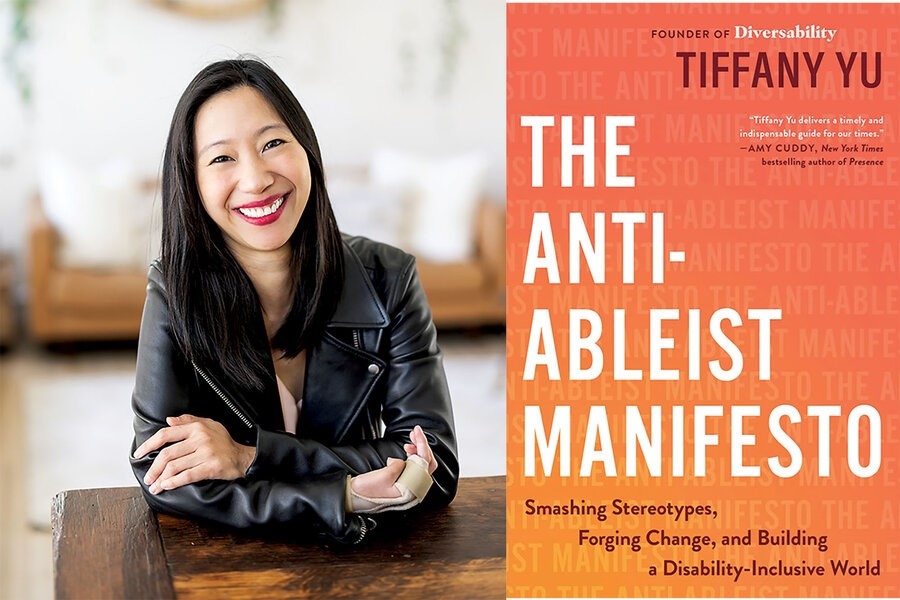REPRINTED WITH PERMISSION FROM THE CHRISTIAN SCIENCE MONITOR
Growing up, Tiffany Yu felt shame about her disability and hid it. Now, the author of “The Anti-Ableist Manifesto” uses her experience to change the narrative.
 Tiffany Yu is the author of “The Anti-Ableist Manifesto.”Meg Marie Photography
Tiffany Yu is the author of “The Anti-Ableist Manifesto.”Meg Marie Photography
When she was a child, Tiffany Yu lost the use of her dominant arm in a car crash. In her early 20s, as a Goldman Sachs intern with a perfectionist bent, she began to see how she had unwittingly internalized the view that disabled people “could not measure up.” Yet she knew there was value in her experience of disability. She founded the organization Diversability to help others find pride in their own stories. Her book, “The Anti-Ableist Manifesto: Smashing Stereotypes, Forging Change, and Building a Disability-Inclusive World,” was released on Oct. 8. She spoke with contributor Jodi Hausen. The interview has been edited and condensed.
What is Diversability?
We’re a disability-employee resource group that exists outside a company: a disability-centered community focused on helping disabled people with their shame-to-pride transformation. Once they achieve that transformation, we find visibility opportunities for them to share their story. I like to say I’m building and funding the things I wish existed when I was younger.
How did you go from feeling shame about your disability to feeling proud of it?
I felt really isolated after becoming disabled. I didn’t ascribe to labels at the time and felt really disempowered. Then I met other disabled people and saw myself as a community-builder first. But as a function of creating Diversability, I became a disability advocate. It gave me the confidence to find my voice; I’ve been on my own transformation. I’m the No. 1 beneficiary of Diversability.
What prompted you to write this book?
I’d been doing presentations about disability inclusion in the workplace and putting out a lot of social media content, including “The Anti-Ableism Series” on TikTok. As that series started to go viral, people reached out asking how to engage more deeply with my work. A literary agent reached out to me. We thought there might be a version of this that could be in book form.
People in our community get really frustrated. There’s a lot of hurt from years and years of living in an ableist society. Learning should never be about shame. I wanted to figure out how I can meet people where they are and make something that’s approachable. For me, it was “Change starts with me and those we can influence.” Once we’re in community, in solidarity with each other, we can make bigger change. So that essentially became this book.
What has been your greatest challenge?
Trying to get people to care who don’t care. It doesn’t feel good for me knowing there are people in the world who still see us as a dehumanized, less-than, powerless group. I may not be able to reach them. When I started this work, I wanted everyone to be part of it, be my ally, show up for me. I’ve learned there are some disabled people who don’t want to be proud of their disabilities. I had to acknowledge that the way we talk about disability isn’t for them. I believe in the trickle-down effect: You get this book; you share the messages with other people. I hope it’s a choir of voices able to reach the people I can’t.
Do you advise people to disclose their disabilities when applying for work, asking for accommodation, or dating?
I’m a fan of accessibility-first cultures. If we create access first, most people don’t have to divulge. I’m a proponent of creating cultures where you say the things you need using the phrase “I would benefit from” and then insert what you need. You don’t have to share what you have. That doesn’t provide much information. You tell me you have ADHD, but then you say the way it manifests is in time management. The barrier is, How can we make sure you meet your deadlines? The barrier isn’t that you have ADHD.
I used to wait until the third date to tell someone about my disabilities. I noticed most people aren’t looking at people’s hands. So there’s no visible marker unless I’m wearing a splint. I realized, when I would wait, it was because I felt shame around that part of myself. I recognize there are people who are uncomfortable that I can’t use one of my arms. In the majority of my pictures, I’m wearing my splint. Now I always wear my splint on a first date because I don’t want to spend a disproportionate amount of time trying to make someone else feel comfortable about this body I’ve lived in for 27 years.
What has been your greatest joy?
I feel like the deepest work is self-love work. So many of us grew up internalizing harmful narratives around disability. My greatest joy is that I like myself. And that was a really long journey to feel so amazing in this disabled body.
Also, being a witness to the growth of some of our community members who come in and don’t think they have a voice, don’t think anyone will care. Diversability turns 15 this year, and I’ve been thinking about why I keep doing this work. It’s because I love our community.
Page created on 11/23/2024 2:03:38 PM
Last edited 11/23/2024 2:10:53 PM
